Copper Kettle: 8 Essential Points For Buying And Care
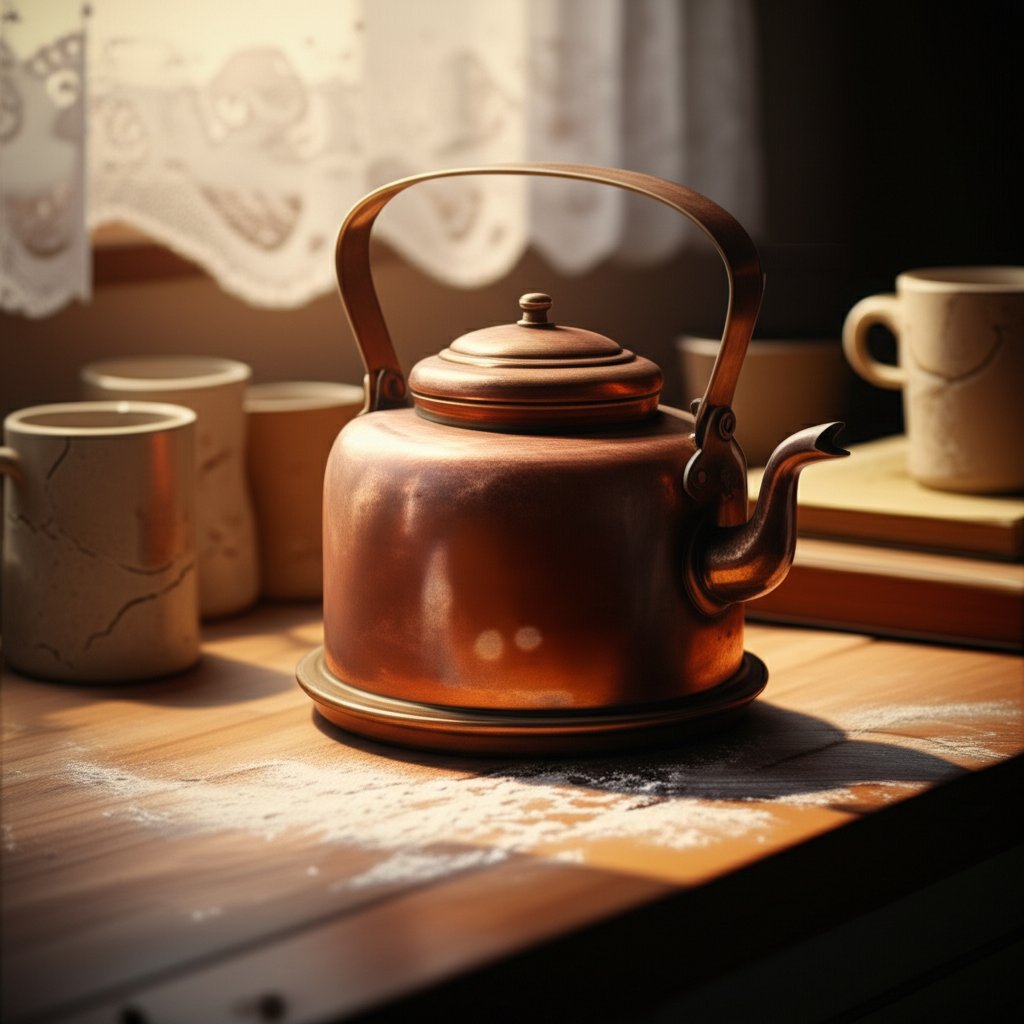
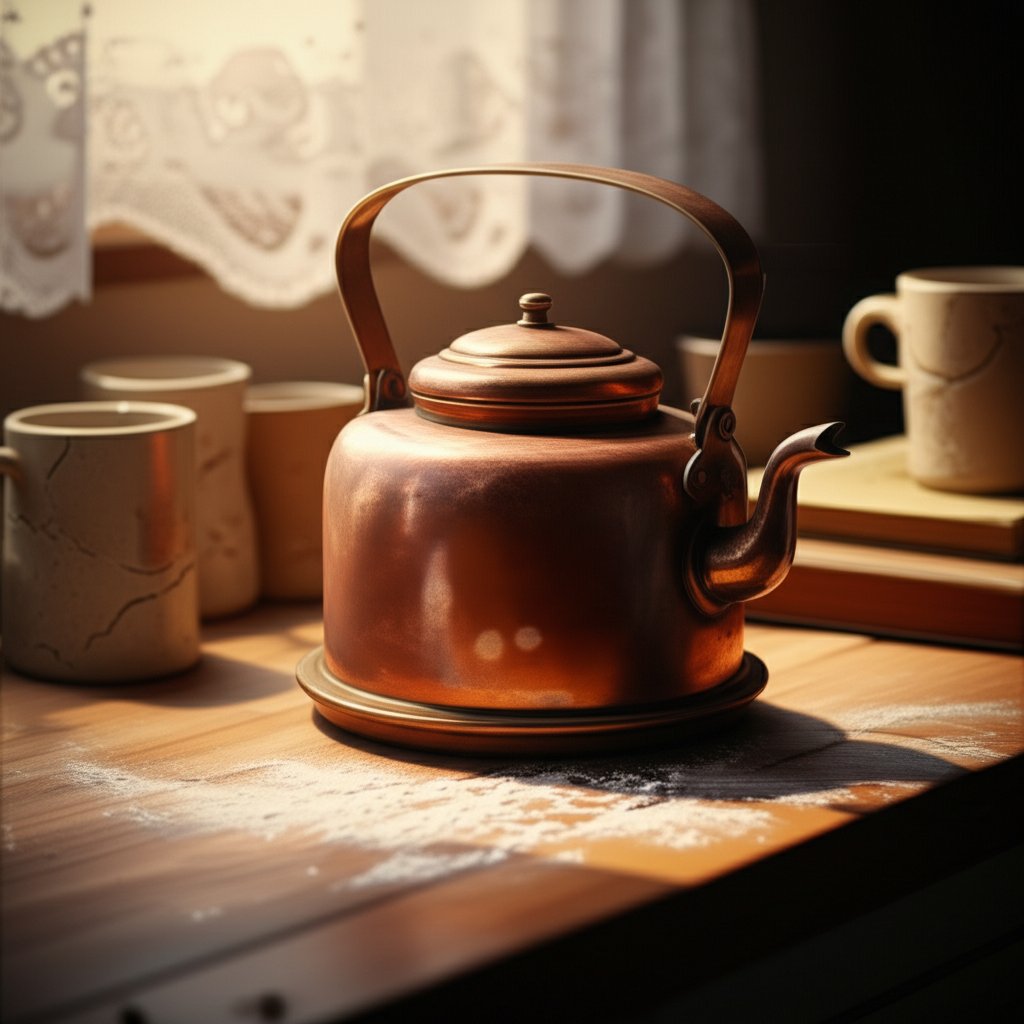
Understanding the copper kettle essentials
When you think about upgrading your kitchen or searching for a timeless piece of cookware, the copper kettle often stands out. But what exactly is a copper kettle, and why do so many cooks and collectors seek them out?
What Makes a Copper Kettle Different
A copper kettle is a vessel made primarily from copper, renowned for its use in boiling water, preparing delicate confections, or even serving as a decorative accent. Unlike common stainless steel pots, copper kettles are prized for their rapid, even heating and precise temperature control. This means you can bring water to just the right temperature for tea or melt sugar for candy without the risk of scorching. The material itself is durable and rust-resistant, holding up well over decades of use if properly cared for (source).
Common Types You’ll See
Shopping for a copper kettle? You’ll notice several forms, each suited to different needs:
- Copper tea kettles: Classic stovetop models, often lined with tin or stainless steel for food safety, designed for boiling water efficiently.
- Copper cooking kettles: Larger, open vessels ideal for making jams, syrups, or even soups in traditional kitchens.
- Antique copper kettles: Vintage or display-only pieces that showcase craftsmanship, often with hand-hammered finishes and unique patina.
- Copper stovetop kettles: Modern or retro-styled options built for daily use on gas or electric ranges.
When Copper Is the Best Choice
So, when should you reach for a copper kettle? If you’re passionate about tea, a copper tea kettle offers quick, responsive heating, making it easier to achieve the perfect brew. For candy-making or jam, a copper cooking kettle helps prevent burning by distributing heat evenly. And if you love kitchen decor, antique copper kettles add warmth and character to any space.
- Primary Benefits of Copper Kettles:
- Superior heat responsiveness—perfect for temperature-sensitive tasks
- Timeless aesthetic appeal—fits both modern and vintage kitchens
- Exceptional durability—lasts for generations with proper care
- Distinct craftsmanship—hammered or polished finishes, unique patinas
For those who value precision, copper’s unmatched temperature control makes it the top choice for tea and confectionery—helping you avoid burnt sugar or bitter tea every time.
It’s worth noting that not all copper kettles are designed for the same use. Some are lined with tin or stainless steel to ensure food safety, especially when heating water or cooking. Unlined antique copper kettles are best reserved for display or boiling water only, as acidic ingredients can react with bare copper.
Before buying, ask yourself: Is this for daily tea, special recipes, or simply to add a touch of old-world charm? Your answer will help you choose the right type and size. And no matter which you select, always check the manufacturer’s manual for care instructions—especially regarding lining maintenance and safe heating practices.
While trends come and go, the enduring qualities of copper—its performance, beauty, and craftsmanship—make it a smart investment for both cooks and collectors. Whether you’re browsing copper stovetop kettles for your morning routine or admiring antique copper kettles for their artistry, you’re choosing a piece with lasting value and function.
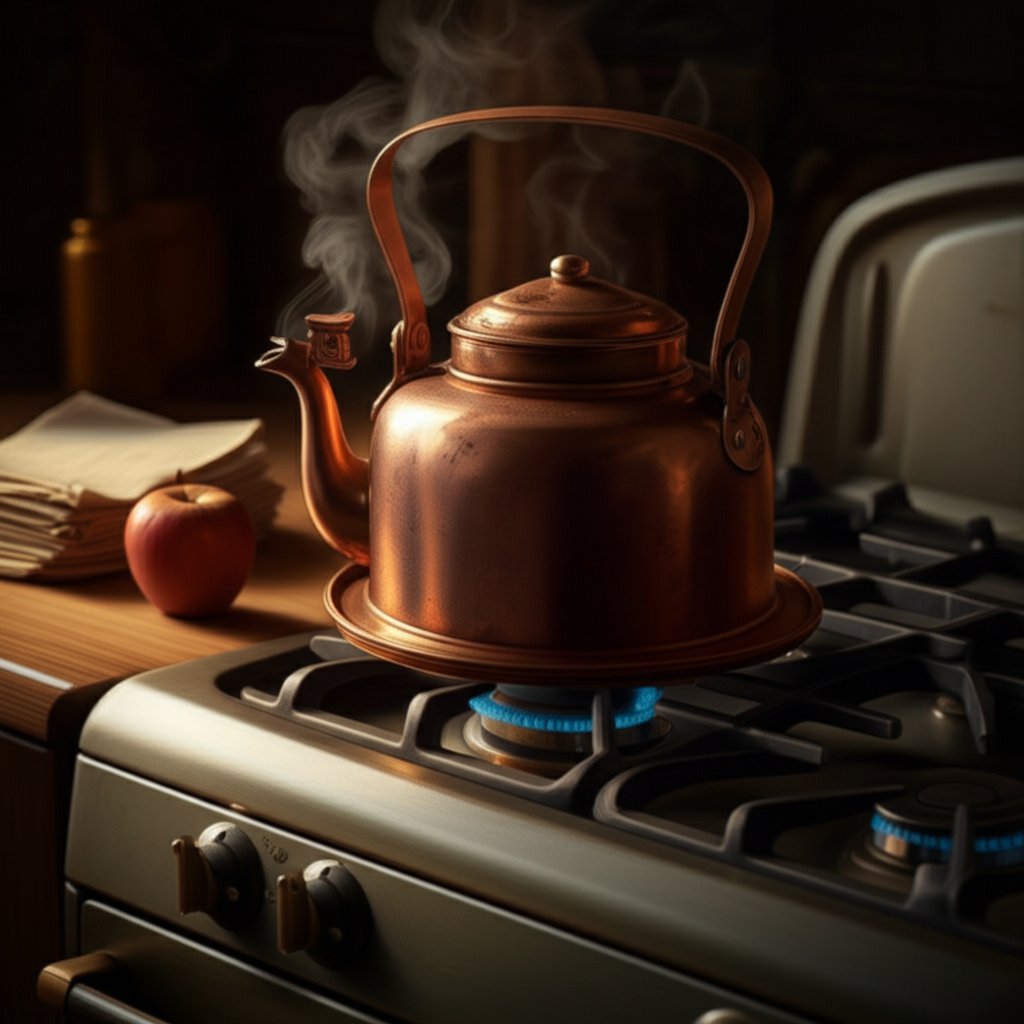
How copper performance affects brewing and cooking
Ever wondered why a solid copper tea kettle is so often the go-to for serious tea drinkers and confectioners? The answer lies in copper’s unique performance, especially compared to other metals. Let’s break down what makes a real copper kettle so effective—and when lining matters most.
Thermal Conductivity and Why It Matters
Imagine you’re heating water for tea or preparing a delicate syrup. You want the temperature to rise quickly, but you also need it to stay even—no hot spots or burned sugar. Copper’s standout trait is its exceptionally high thermal conductivity—at 385 W/(m/K), it's about 60% higher than aluminum and far ahead of stainless steel. This means a pure copper kettle heats up fast and distributes heat evenly, giving you precise control, whether you’re brewing tea just below a boil or simmering a sauce for perfect consistency.
- Heats and cools rapidly—prevents overboiling or scorching
- Delivers uniform temperature across the entire surface
- Ideal for temperature-sensitive tasks: tea brewing, candy making, jam preparation
- Works well on most gas and electric stovetops (but check for induction compatibility)
Tin Lined vs Stainless Lined Interiors
Most copper stove top kettles and cookware aren’t just bare copper inside. Why? Because copper is a reactive metal. Lining the interior with tin or stainless steel makes your stove top copper kettle safer and more versatile:
- Tin lining: Delivers a classic, almost nonstick-like cooking experience. Tin is highly nonreactive, so it prevents copper from leaching into your water or food. The trade-off? Tin can wear over time and may require professional re-tinning if you use your kettle often or at high temperatures.
- Stainless steel lining: More durable and lower maintenance than tin, but with slightly less heat sensitivity. Still, it’s a great option for everyday use and longevity.
Unlined Kettles and Appropriate Uses
Not all copper kettles are lined. Unlined kettles—often found in copper antique collections or as specialty cookware—are best for certain uses:
- Beating egg whites (as in classic copper mixing bowls)
- Making jams or syrups where sugar helps buffer acidity
- Decorative purposes—especially for old copper tea kettle collectors
Always avoid boiling acidic liquids (like lemon water or tomato sauces) in unlined copper. This can cause copper to leach into your food, impacting both taste and safety.
In summary, if you want the best heat control for tea or candy, a lined real copper kettle is your friend. For decorative or specialty tasks, unlined copper has its place—but always check the intended use and consult the maker’s care guidelines if you’re unsure. Next, let’s explore how to match the right style and size of kettle to your specific needs, whether you’re brewing, cooking, or collecting.
Choosing the right copper kettle for your goals
When you’re searching for a copper kettle for sale, it’s easy to be dazzled by the shine and artistry—but the best choice depends on how you plan to use it. Do you crave the perfect cup of tea, need a workhorse for candy-making, or want a striking display piece? Let’s break down the features and styles so you can confidently match your needs to the right kettle, whether you’re shopping new or exploring copper kettles for sale at antique shops or online.
Best Copper Kettle Choices for Tea Lovers
If your main goal is daily tea brewing, you’ll want a kettle that’s comfortable, safe, and efficient. Look for models with:
- Well-balanced, ergonomic handles—often wrapped or made of wood to protect your hand from heat (like a vintage copper tea kettle with wood handle).
- Tight-fitting lids to prevent steam loss and spills.
- Precision spouts that pour smoothly, avoiding drips and splashes.
- Whistle options to alert you when water boils.
- Compatibility with your stove—most copper tea kettles work well on gas or electric, but double-check if you use induction.
For most homes, a 1-1.8 quart kettle strikes a balance between daily convenience and not taking up too much space. A copper tea kettle vintage style can add both function and classic charm to your kitchen.
Choosing a Copper Cooking Kettle for Confections
Making jams, candies, or syrups? Here, a copper kettle large enough for big batches is a must. Open, wide-mouthed copper cooking kettles allow for rapid, even heating and easy stirring—key to preventing scorching when working with sugar. Look for:
- Sturdy, heat-resistant handles—preferably double-riveted for safety.
- Large capacity (2-3 quarts or more) for flexibility in batch size.
- Interior lining (tin or stainless) for safe food preparation.
- Easy-to-clean surfaces, since sticky residues are common in confectionery work.
Remember, larger kettles require more storage space and are heavier when full—so balance your ambitions with practicality.
Decor and Display Considerations
If you’re drawn to copper for its visual impact, focus on details that highlight craftsmanship and history. Decorative and antique models often feature:
- Hand-hammered or pebbled finishes for texture and strength.
- Unique patinas that deepen with age, adding character.
- Riveted joints and ornate handles—look for a vintage copper tea kettle with wood handle for a classic touch.
- Distinctive shapes and engravings, especially in copper tea kettle vintage designs.
Display pieces don’t need to be food-safe, but if you want versatility, choose lined and structurally sound models. Antique kettles can be investment pieces, so consider the copper kettle price and condition when buying.
| Category | Typical Capacity | Lining Type | Pour Control | Ease of Cleaning | Best For |
|---|---|---|---|---|---|
| Tea Brewing | 1–1.8 quarts | Tin or stainless | Precision spout, often with whistle | Easy (narrower opening) | Daily use, small groups |
| Confectionery/Cooking | 2–3+ quarts | Tin or stainless | Wide mouth for stirring | Moderate (wider opening, stickier residues) | Jams, candy, large batches |
| Decor/Display | Varies (often larger) | May be unlined | Not intended for pouring | Low (for display only) | Decor, collecting |
Tip: The bigger the kettle, the more important sturdy handles and balanced weight become. Always test grip and pour before buying, especially for a copper kettle large enough for family gatherings or jam sessions.
Before you choose an oversized or heavy model, consider how often you’ll use it and where you’ll store it. For occasional use or display, a larger kettle can be a stunning centerpiece. For daily brewing, smaller, ergonomic designs are easier to handle and clean. Reading copper kettle reviews can also help you spot practical pros and cons before you commit.
Next, we’ll explore how to identify authentic antique copper kettles, so you can buy with confidence and appreciate the unique heritage each piece brings to your kitchen or collection.
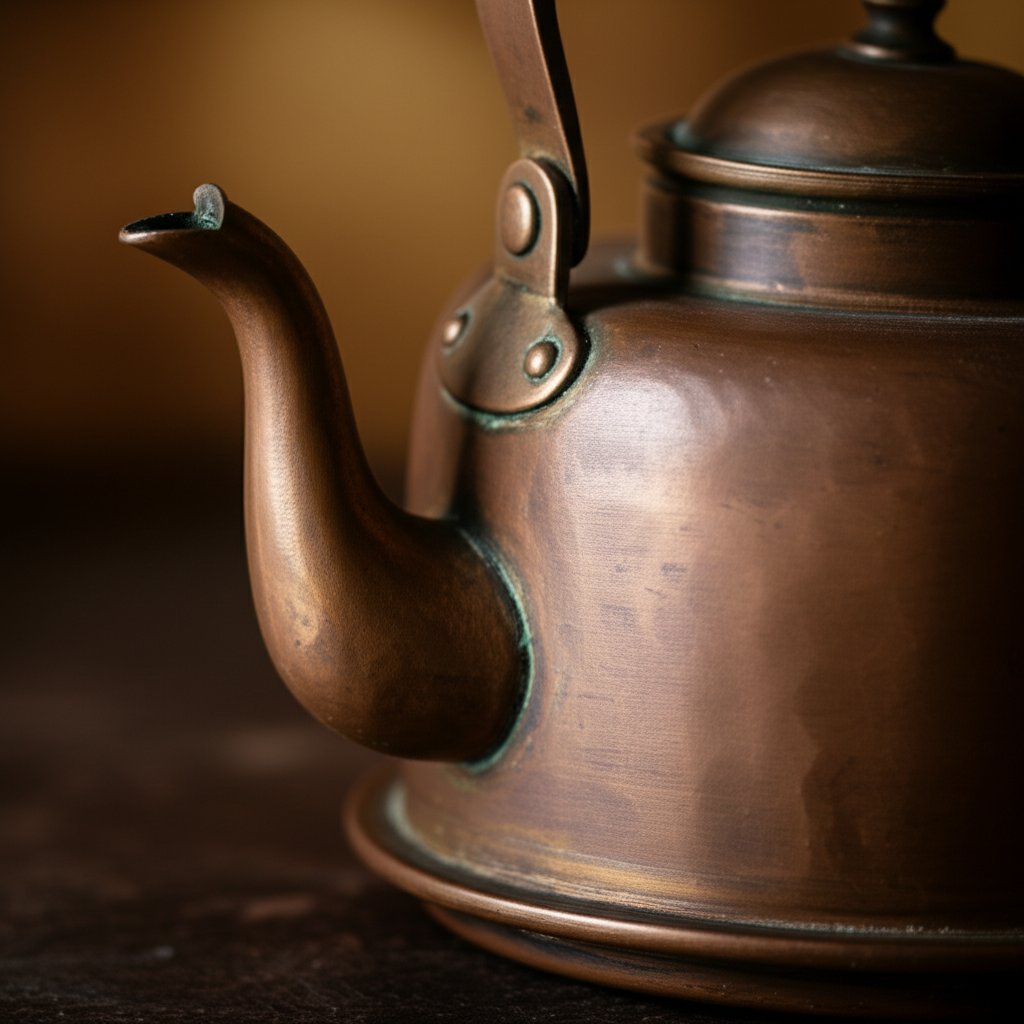
Identifying authentic antique copper kettles
Ever wondered if that gleaming antique copper kettle you spotted is the real deal, or just a convincing reproduction? With so many styles and ages on the market, it can feel daunting to separate genuine antiques from clever lookalikes. Let’s break down the essential clues and practical steps to help you confidently assess any old copper kettle or antique copper tea kettle you encounter.
Reading Seams, Rivets, and Hammer Marks
Start by examining the construction. Early kettles—especially those from the kettle 1800s era—often feature dovetailed seams, where strips of copper are interlocked and soldered, rather than simply welded. This labor-intensive joinery is a hallmark of older, hand-crafted pieces. Next, look for hand-hammered surfaces: authentic antique kettles will show subtle, irregular hammer marks, a sign of true craftsmanship. The copper should feel thick and substantial, as thinner, lightweight bodies are usually modern imitations. Pay close attention to the rivets attaching the handle and spout—handmade rivets are typically less uniform and may have slight variations, while machine-made ones are perfectly identical.
- Inspect the seams for dovetailing or clear solder lines—these suggest pre-20th-century workmanship.
- Check for hammering: authentic antique copper tea kettles will have uneven, overlapping marks, not a smooth or machine-patterned finish.
- Feel the weight: thick gauge copper denotes quality and age.
- Look at handle attachments: older pieces use hand-forged rivets, often with a slightly domed or irregular head.
Understanding Patina and Wear Patterns
Imagine a copper tea pot antique that has seen decades of use. Over time, copper develops a rich, uneven patina—a darkening or mottling of the surface that can’t be faked overnight. Authentic antiques show wear in logical places: around the handle, spout, and lid, where hands and heat have left their mark. Uniform color or artificially bright copper may signal recent polishing or reproduction. Collectors often prefer patina left intact, as it tells the story of the kettle’s journey through time (Hemswell Antiques).
- Check for natural patina—look for color variation and signs of age, not just a shiny surface.
- Examine the interior lining: evidence of re-tinning or darkened tin is normal, but exposed copper inside means it’s time for relining before food use.
- Look for repairs or solder residue, which may indicate a long service life or past restoration.
Maker Marks and What They Can Tell You
Authentic antique copper kettle markings can be a goldmine for identification. Flip the kettle over and scan for stamps—these might include the maker’s name, a store, size numbers, or even an owner’s initials. Stamps help date the piece and sometimes connect it to a particular region or coppersmith (Vintage French Copper). However, not every genuine antique kettle will have visible marks, so absence isn’t proof of a fake.
- Look for clear, deep stamps or markings on the base or handle.
- Compare marks to documented examples from trusted resources or field guides.
- Photograph the seams, rivets, and marks for your records and future reference.
Always request provenance documents, previous invoices, or restoration notes if available. These can provide valuable context and increase your confidence in the kettle’s authenticity.
Inspection Steps Before You Buy
| 1. | Examine interior lining for signs of re-tinning or exposed copper. |
| 2. | Check hammering for irregularity and authenticity. |
| 3. | Inspect handle materials and rivet attachments for hand-forged quality. |
| 4. | Look for repairs, solder residues, or replaced parts. |
| 5. | Document all findings with clear photos for future comparison. |
Spotting Reproductions and Ethical Buying
Reproductions are sometimes very convincing, but they usually have machine-uniform patterns, too-bright new rivets, or a patina that looks artificial. If a copper tea pot antique seems too perfect, pause and investigate further. Ethical buying means disclosing any restorations or repairs if you plan to resell, and consulting reputable antique dealers or museum conservation guidelines when in doubt.
For deeper verification, compare your findings with trusted references and consider seeking a second opinion from a metals conservation expert. This careful, step-by-step approach helps ensure that your next antique copper tea pot is both a beautiful and genuine addition to your collection.
Buying and valuation guidance that protects your budget
When you’re ready to invest in an antique copper kettle, it’s easy to get swept up by the beauty and history of each piece. But how do you know if you’re getting true value for your money? Whether you’re searching for an antique copper kettle for sale or eyeing a vintage copper teapot on a digital marketplace, a careful inspection and a clear understanding of value drivers will help you make a smart, satisfying purchase.
Pre-purchase Inspection Checklist
Sounds complex? Here’s a practical checklist to guide your evaluation before you buy:
- Thickness and dents: Thicker copper (2.5mm and above) is more valuable and functional. Check for major dents or warping, as these can impact both performance and value.
- Handle mounts: Ensure handles are securely attached with tight, original rivets. Loose or replaced handles may signal repairs or lower quality.
- Hinge and lid fit: Lids should fit snugly. Gaps or wobbles can indicate damage or mismatched parts.
- Spout integrity: Inspect for cracks, splits, or signs of soldering—especially in older copper kettles antique collectors prize.
- Lining condition: For cooking use, check if the tin or stainless lining is intact. Exposed copper inside means the kettle may need professional re-tinning.
- Signs of over-polishing: Excessive shine or loss of detail can mean aggressive cleaning, which sometimes erases maker’s marks or thins the copper.
- Restoration evidence: Look for traces of recent soldering, replaced hardware, or non-original parts. Ask for documentation if available.
Request clear photos of the seams, base, and any stamps or markings. This helps you compare details with trusted references and avoid surprises.
Factors That Influence Value
What determines the antique copper kettle value or the value of antique copper kettle you’re considering? Let’s break it down in a simple comparison:
| Value Driver | Higher Value Indicators | Lower Value Indicators |
|---|---|---|
| Age & Era | Pre-1930s, thick gauge, dovetailed seams | Modern, thin gauge, welded seams |
| Craftsmanship | Hand-hammered, original rivets, clear maker’s marks | Machine-made, uniform finish, missing or faint marks |
| Rarity & Provenance | Stamped by well-known coppersmith, documented history | Unmarked, mass-produced, no provenance |
| Condition | Minimal dents, intact lining, original parts | Heavy dents, worn or missing lining, replaced parts |
| Restoration Quality | Professionally re-tinned, quality repairs, documentation included | Poorly repaired, amateur tinning, undocumented changes |
For example, a vintage copper teapot with original marks and a well-preserved tin lining will generally command a higher price than a similar piece with heavy repairs or missing parts. The antique copper tea kettle value can also be influenced by the maker’s reputation and the kettle’s documented history.
Before you commit, always weigh the cost of necessary restoration—like re-tinning—against the asking price. Restoration can add significant expense and downtime, so factor this into your decision.
Where to Buy and What to Ask
When shopping for antique copper kettles for sale or browsing antique copper tea kettle for sale listings, consider these tips:
- Stick to reputable platforms (e.g., eBay, Etsy) that offer buyer protection and dispute resolution.
- Cross-check multiple listings and dealer references to understand fair market value.
- Request detailed photos and ask direct questions about repairs, lining condition, and provenance.
- For display-only pieces, remember that beauty doesn’t guarantee food safety—unlined or heavily worn kettles are best kept as decor.
- Don’t be afraid to request documentation or restoration records, especially for high-value or rare pieces.
For online purchases, use secure payment methods and review return policies before finalizing your order. Comparison shopping helps you spot fair pricing, and robust buyer protection gives you peace of mind.
Ultimately, the true value of a copper kettle—antique or vintage—depends on its physical condition, craftsmanship, and your intended use. Avoid making assumptions based on appearance alone; whenever possible, inspect in person or consult a trusted expert before investing in a high-ticket item. This careful approach ensures your next copper kettles antique find is both a wise purchase and a lasting treasure.
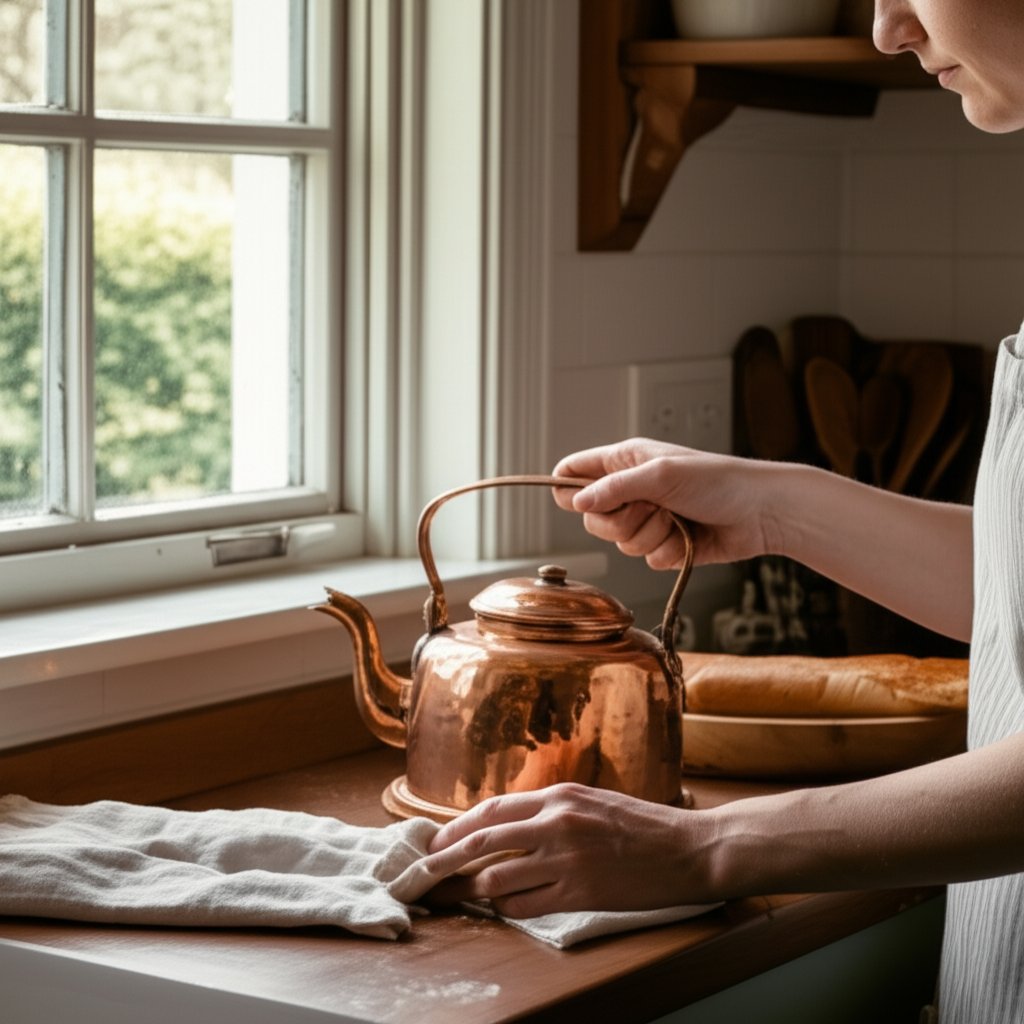
Care, Cleaning, and Safety for Lasting Performance
When you finally bring home that vintage copper kettle or discover a family heirloom tucked away, one question always comes up: How do you keep it beautiful and safe to use, year after year? Whether you’re caring for a modern piece or a copper kettle vintage with generations of history, the right maintenance routine keeps your kettle both functional and full of character.
Routine Cleaning Without Damaging the Finish
Sounds complex? Not at all. Imagine you’ve just brewed tea in your vintage copper tea kettle. Here’s a simple, stepwise cleaning routine to preserve its shine and prevent damage:
- Rinse with warm water as soon as possible after use to remove residue.
- Wash gently with a few drops of mild dish soap and a soft cloth or nonabrasive sponge. This removes stains without scratching the copper or its lining.
- Dry thoroughly with a clean, soft towel to prevent water spots and streaks.
- Polish the exterior (optional): For extra shine, use a copper-safe polish or a homemade paste of lemon juice and salt. Rub gently, rinse, and buff dry. If you prefer a natural patina, polish less often and enjoy the aged look (NYT Wirecutter).
- Avoid abrasive pads or harsh chemicals—these can scratch both the copper and any tin or stainless lining.
Polishing the Exterior Responsibly
Do you love the look of a freshly polished hammered copper kettle, or do you prefer the soft glow of natural patina? Both are valid! If you choose to polish, use only non-abrasive products—either a commercial copper polish or a homemade mix of lemon juice and baking soda. Always spot-test on a hidden area first, especially with vintage copper teapots, to make sure it won’t damage the finish or lining. For display-only kettles, a light coat of mineral oil or beeswax can add protection and slow future tarnish.
Lining Care and Food Safety
Not sure if your kettle is lined with tin or stainless? Peek inside—tin linings are soft and silvery, while stainless appears harder and shinier. For food use, always keep the lining intact:
- Never use abrasive cleaners on the interior, as these can wear down the lining.
- Avoid acidic solutions (like vinegar or lemon) inside unlined kettles, since these can cause copper to leach into your water or food.
- Do not boil your kettle dry—this can warp the metal and damage the lining.
- Regularly check handles and hardware; tighten any loose screws or rivets before each use. Never lift a full, boiling kettle by a compromised handle.
If you notice copper showing through a worn tin lining, stop using the kettle for food or drink immediately. Seek professional re-tinning to restore safety before further use.
- Consult manufacturer manuals or food safety agency guidance if you’re unsure about lining materials or reactivity.
- For older or vintage copper teapots, document any cleaning or repairs you perform—this preserves provenance and helps future caretakers.
- Store your kettle in a dry, cool place to prevent tarnish and corrosion from moisture exposure.
By following these simple steps, you’ll keep your copper kettle vintage or new—gleaming and safe for daily use. Next up, we’ll explore restoration and repair, so you’ll know when professional help is needed to keep your kettle in top shape.
Restoration and repair done the right way
When you uncover a large antique copper kettle at a market or inherit a copper tea kettle antique from family, the urge to restore its beauty and function is natural. But how do you do it right—preserving both value and authenticity? Let’s break down when restoration is worth it, the safest ways to proceed, and how to address missing or damaged parts with confidence.
When to Re-tin or Replace Linings
For any copper kettle antique you intend to use for food or drink, the lining is crucial. Most antiques were originally lined with tin, which wears away over years of use. If you spot exposed copper inside—especially areas the size of a quarter or larger—it’s time for professional re-tinning. This process restores food safety and prevents metallic flavors. For display-only or purely decorative vintage large copper kettle pieces, relining isn’t strictly necessary, but a well-maintained interior can add to the value and versatility.
- Re-tinning: Essential for food use; seek specialists who work with antique cookware.
- Stainless relining: Rare for antiques, but sometimes chosen for durability in modern kitchen use.
- Unlined interiors: Acceptable for display or dry storage only—never use for acidic foods or beverages.
Dent Removal and Structural Repairs
Imagine you’ve found an antique large copper kettle with a few dents or a loose handle. Should you fix it? If the dents are minor and don’t affect function, you might leave them as part of the kettle’s story. But for major dents, warped bases, or cracked solder joints, professional restoration is best. Experts use forms and gentle pressure to reshape copper, avoiding further stress or cracks. Solder repairs should be neat and minimal to maintain both strength and appearance.
- Reshape dents with proper forms and tools—never hammer directly on the copper.
- Repair or reinforce soldered seams and joints for safety and longevity.
- Replace missing or heavily corroded rivets with period-appropriate hardware.
Replacing Handles, Lids, and Knobs
Missing or broken hardware is common with copper kettle antique finds. Here, authenticity and fit are everything. Replacement knobs, handles, or hinges must match the original style and fit existing holes for both safety and value. If you can’t source period-correct parts locally, modern CNC machining services—like those offered by XTJ—can fabricate custom brass or copper hardware with ultra-tight tolerances, ensuring a safe, rattle-free fit that respects the kettle’s era and design. This is especially helpful for rare pieces or when you need a precise match to restore a copper electric kettle antique or antique copper electric kettle to its former glory.
- Local Restorers: Often have experience with antique copper and can match patina and style.
- Custom CNC Services (e.g., XTJ): Ideal for high-precision, hard-to-source parts; can work from original designs or detailed measurements.
| Service Option | Pros | Cons |
|---|---|---|
| Local Restorer |
|
|
| CNC Machining (XTJ) |
|
|
Always keep detailed records and photos of every intervention—re-tinning, repairs, or hardware replacements. This documentation preserves provenance and helps future caretakers understand your copper kettle antique's journey.
Restoring a vintage large copper kettle or a rare antique copper electric kettle is about more than just looks—it’s about honoring craftsmanship and ensuring safe, lasting use. Whether you choose a trusted local restorer or a precision CNC service for custom parts, compare quotes, check capabilities, and make sure the work respects the kettle’s history. Next, we’ll wrap up with final recommendations and resources for your restoration journey.
Final recommendations and useful resources
Ready to make the most of your copper kettle journey? Whether you’re eyeing an antique copper teapot for your collection or want your vintage copper kettles to shine for years, a thoughtful approach ensures lasting satisfaction. Let’s wrap up with the key takeaways, a checklist for confident action, and trusted resources to guide your next steps.
Key Takeaways Before You Buy or Restore
- Choose lined kettles for cooking: Tin or stainless linings protect both food safety and kettle longevity.
- Authenticate antiques by construction: Dovetailed seams, hand-hammered finishes, and original rivets are hallmarks of genuine antique copper tea kettles.
- Budget for re-tinning and repairs: If you plan to use your kettle, factor in the cost of professional re-tinning or restoration, especially for vintage copper tea kettles with worn linings.
- Maintain gently to protect value: Use non-abrasive cleaning, avoid harsh chemicals, and document any work or restoration for provenance.
- Align your choice to intended use: Decide whether your kettle is for daily tea, special recipes, or display—each purpose has different feature priorities.
Trusted Resources and Documentation Tips
Sounds complex? Not if you keep organized. Here’s a quick checklist to help you stay on track:
- Document all inspections and repairs with clear photos—especially seams, linings, and marks.
- Request provenance or restoration records when buying, particularly for antique copper teapots or high-value pieces.
- Verify lining condition before use; consult a professional if you’re unsure.
- Consult manufacturer manuals and conservation guides for care routines—these often include best practices specific to copper and antique cookware.
- Keep a maintenance log for each kettle, noting cleaning, repairs, and any professional interventions.
Remember: Safety and structural integrity always outweigh cosmetic shine. Never use a kettle with exposed copper lining for food or drink until it’s professionally restored.
When to Seek Professional Help
Imagine you’ve found a rare antique copper tea kettle with a missing knob or a loose handle. Should you try to fix it yourself? For simple cleaning and regular care, DIY is fine. But for structural repairs, re-tinning, or fabricating missing parts, professional help is best. Local restorers are great for matching patina and style, while precision CNC services—like XTJ—offer custom hardware solutions with tight tolerances for a perfect, safe fit. Always get multiple quotes and confirm that the chosen service can match your kettle’s material and finish.
- Manufacturer manuals and official care guides
- Conservation and restoration specialists
- Custom CNC machining services for hardware (e.g., XTJ)
- Antique kitchenware dealers and appraisers
By following these steps and using reputable resources, you’ll enjoy your vintage copper kettles or antique copper tea kettles safely—while preserving their beauty and value for years to come. With knowledge, care, and the right support, your copper treasures can truly stand the test of time.
Frequently Asked Questions About Copper Kettles
1. Are copper kettles safe to use for boiling water or making tea?
Copper kettles are safe for boiling water and making tea when they have a tin or stainless steel lining inside. This lining prevents copper from reacting with water or acidic ingredients, ensuring food safety. Unlined antique copper kettles should be reserved for display or for boiling water only, as copper can leach into acidic liquids.
2. What are the main benefits of using a copper tea kettle?
Copper tea kettles heat water rapidly and distribute heat evenly, making them ideal for precise temperature control. This helps achieve the perfect brew for tea and prevents scorching when making confections. Additionally, copper kettles add a timeless aesthetic to your kitchen and are known for their durability when properly cared for.
3. How can I tell if a copper kettle is a genuine antique?
Look for dovetailed seams, hand-hammered surfaces, thick copper walls, and irregular rivets—these are signs of traditional craftsmanship. Genuine antiques often have a natural patina and may display maker’s marks or stamps. Uniform patterns or overly shiny rivets can indicate a reproduction. Documentation and provenance further support authenticity.
4. What should I check before buying an antique copper kettle?
Inspect for thick copper, secure handle mounts, snug-fitting lids, intact linings, and original rivets. Look for signs of over-polishing or amateur repairs. Request clear photos of seams, base, and any markings. If the kettle is for food use, ensure the lining is safe or budget for professional re-tinning.
5. Can damaged or missing parts on an antique copper kettle be restored?
Yes, damaged or missing hardware such as handles, knobs, or rivets can often be restored. Local restorers can match patina and style, while CNC machining services like XTJ can fabricate custom brass or copper parts with precise fit. Always document restoration work and compare quotes to maintain value and authenticity.
-
Posted in
antique copper kettle, copper kettle, copper tea kettle, kettle restoration, kitchen collectibles





